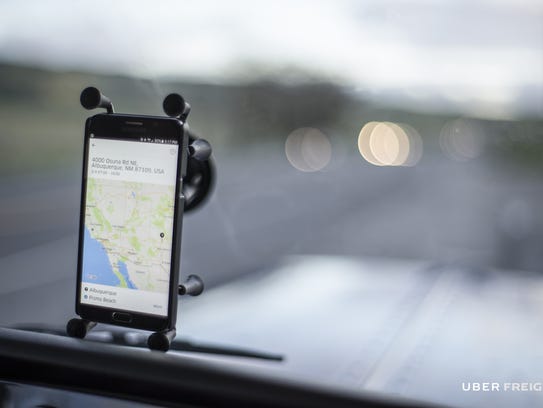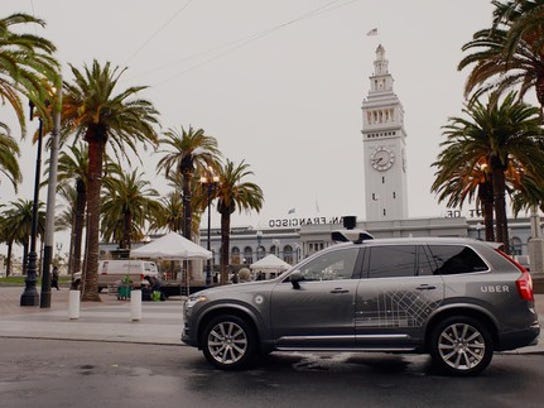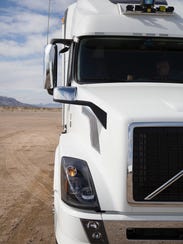Robot can produce robots and repair robots, do everything including sex and war. Why still need billions of humans? Time to nuke away billions! Stop spoiling humans and waste planet earth resources! Reduce 8 billions to 8 millions, served by 80 million robots. Good enough? Nuke all the excess billions away ASAP!
https://www.usatoday.com/story/tech...shuttling-goods-arizona-no-drivers/397123002/
Uber trucks start shuttling goods across Arizona — by themselves
Marco della Cava, USA TODAY Published 10:00 a.m. ET March 6, 2018 | Updated 2:47 p.m. ET March 6, 2018
CLOSE

Uber's autonomous trucks are making their first runs in Arizona. Time
TWEETLINKEDIN 6 COMMENTEMAILMORE
SAN FRANCISCO — Uber has been sending self-driving trucks on delivery runs across Arizona since November, the first step in what promises to be a freight transportation revolution that could radically reshape the jobs of long-haul truckers.
After testing its technology earlier in 2017, Uber began contracting with trucking companies to use its own autonomous Volvo big rigs to take over loads as they traverse the state, it disclosed.
In Uber‘s current program, human truckers meet the self-driving truck at the Arizona border, which then takes their load across the state and hands it off to another human trucker. An Uber employee rides in the driver seat during the autonomous trip.
If one day both the technology and regulations play out in favor of self-driving trucks, two scenarios emerge.
The first would find self-driving trucks handling long-haul highway legs with no one at the wheel as they meet up with human truckers who then handle deliveries into city centers. The other possibility is Uber selling its technology to trucking owner-operators who then leverage it to sleep while the truck handles the bulk of long-distance driving.
Truckers make their money only when their rigs are on the road. They are also limited by law in terms of how much time they can spend behind the wheel, something a self-driving truck could impact positively.
"The big step for us recently is that we can plan to haul goods in both directions, using Uber Freight to coordinate load pickups and dropoffs with local truckers," said Alden Woodrow, who leads Uber's self- driving truck effort. "Keeping trucking local allows these drivers to make money while staying closer to home."
More: Why Uber and Lyft want to take you to the hospital
More: Uber, Lyft drivers actually earn less than minimum wage, MIT survey suggests
Uber Freight, which launched last May, is an app that matches shippers with loads using technology drawn from Uber's ride-hailing app. Typically such trucking logistics have been coordinated through phone calls and emails.
Uber isn't alone in its pursuit of self-driving truck technology, with startups such as Embark joining companies such as Tesla and its new Tesla Semi to carve out a slice of a $700 billion industry that moves 70% of all domestic freight, according to the American Trucking Association.
Despite the push, the technology behind self-driving trucks remains in its infancy, with hurdles that include government regulations and trucker buy-in.
Given that truckers only make money only when their rigs are on the road, the business model gives them incentive to drive as long as possible. A truck that makes the long hauls between exits, allowing a driver to sleep in the cab, could increase their profit. But they'd have to trust the technology, as well as fork over what promises to be a considerable investment to make their cabs autonomous.
Woodrow says Uber's trucking plans remain in development, but he does not see the company running a fleet of self-driving trucks — which would imply that its technology would be available for purchase from large established shipping companies.

Uber Freight, an app that connects drivers with loads, is expanding nationally. (Photo: Uber Freight)
"Today we're operating our own trucks, but in the future it remains to be seen what happens," he says. "Trucking is a very large and sophisticated business with a lot of companies in the value chain who are good at what they do. So our desire is to partner."
Uber's trucks stick to the highway
Uber's current Arizona pilot program does not feature trucks making end-to-end runs from pick-up to delivery because it’s tough to make huge trucks navigate urban traffic on their own.
Instead, Uber's Volvo trucks are given loads at border weigh stations. These trucks are equipped with hardware, software and an array of sensors developed by Uber's Advanced Technologies Group that help the truck make what amounts to a glorified cruise-control run across the state. Uber ATG also is behind ongoing self-driving car testing in Arizona, Pennsylvania and San Francisco.
Uber did not disclose what items it is transporting for which companies.

Uber deployed prototype self-driving Volvos in San Francisco in late 2016. (Photo: Volvo Cars)
Once the Uber trucks exit at the next highway hub near the Arizona border, they are met by a different set of truckers who hitch the trailer to own their cab to finish the delivery.
The idea is that truckers get to go home to their families instead of being on the road. In a video Uber created to tout the program, the company showcases a California trucker who, once at the Arizona border, hands his trailer over to an Uber self-driving truck for its trip east, while picking up a different load that needs to head back to California.
Autonomous vehicles are being pursued by dozens of companies ranging from large automakers to technology startups. Slowly, states are adapting their rules to try and be on the front lines of a potential transportation shift.
Michigan, California and Arizona, for example, have been constantly updating their autonomous car testing laws in order to court companies working on such tech. California recently joined Arizona in announcing that it would allow self-driving cars to be tested without a driver at the wheel.
Skeptics of the self-driving gold rush include the Consumer Watchdog Group's John Simpson, who in a recent letter to lawmakers said “any autonomous vehicle legislation should require a human driver behind a steering wheel capable of taking control."
Uber refocuses after lawsuit
Uber's announcement aims to cast a positive light on the company's trucking efforts, and comes a few weeks after it settled a contentious year-old lawsuit brought by Waymo, the name of Google's self-driving car program.
Waymo's suit argued that Uber was building light detection and ranging sensors — roof-top lasers that help vehicles interpret their surroundings — based on trade secrets stolen by Anthony Levandowski, who left Waymo to start a self-driving truck company called Otto. Months after its creation in early 2016, Uber bought Otto for around $680 million.

Uber's trucks only complete highway runs, meeting local truck drivers at hubs by exits in order to transfer their goods for local delivery. (Photo: Gregory Murphy)
Last year, Travis Kalanick, the Uber CEO who negotiated the deal with Levandowski, was ousted from the company he co-founded after a rash of bad publicity surrounding charges that Uber ran a sexist operation that often skirted the law. Levandowski was fired by Uber after he repeatedly declined to answer questions from Waymo's lawyers.
In settling the suit, Uber had to give Waymo $245 million in equity but it did not admit guilt. Uber has long maintained that its LiDAR was built with its own engineering know-how.
"Our trucks do not run on the same self-driving (technology) as Otto trucks did," says Woodrow. "It's Uber tech, and we're improving on it all the time."
Follow USA TODAY transportation tech writer Marco della Cava on Twitter.
https://www.usatoday.com/story/tech...shuttling-goods-arizona-no-drivers/397123002/
Uber trucks start shuttling goods across Arizona — by themselves
Marco della Cava, USA TODAY Published 10:00 a.m. ET March 6, 2018 | Updated 2:47 p.m. ET March 6, 2018
CLOSE
Uber's autonomous trucks are making their first runs in Arizona. Time
TWEETLINKEDIN 6 COMMENTEMAILMORE
SAN FRANCISCO — Uber has been sending self-driving trucks on delivery runs across Arizona since November, the first step in what promises to be a freight transportation revolution that could radically reshape the jobs of long-haul truckers.
After testing its technology earlier in 2017, Uber began contracting with trucking companies to use its own autonomous Volvo big rigs to take over loads as they traverse the state, it disclosed.
In Uber‘s current program, human truckers meet the self-driving truck at the Arizona border, which then takes their load across the state and hands it off to another human trucker. An Uber employee rides in the driver seat during the autonomous trip.
If one day both the technology and regulations play out in favor of self-driving trucks, two scenarios emerge.
The first would find self-driving trucks handling long-haul highway legs with no one at the wheel as they meet up with human truckers who then handle deliveries into city centers. The other possibility is Uber selling its technology to trucking owner-operators who then leverage it to sleep while the truck handles the bulk of long-distance driving.
Truckers make their money only when their rigs are on the road. They are also limited by law in terms of how much time they can spend behind the wheel, something a self-driving truck could impact positively.
"The big step for us recently is that we can plan to haul goods in both directions, using Uber Freight to coordinate load pickups and dropoffs with local truckers," said Alden Woodrow, who leads Uber's self- driving truck effort. "Keeping trucking local allows these drivers to make money while staying closer to home."
More: Why Uber and Lyft want to take you to the hospital
More: Uber, Lyft drivers actually earn less than minimum wage, MIT survey suggests
Uber Freight, which launched last May, is an app that matches shippers with loads using technology drawn from Uber's ride-hailing app. Typically such trucking logistics have been coordinated through phone calls and emails.
Uber isn't alone in its pursuit of self-driving truck technology, with startups such as Embark joining companies such as Tesla and its new Tesla Semi to carve out a slice of a $700 billion industry that moves 70% of all domestic freight, according to the American Trucking Association.
Despite the push, the technology behind self-driving trucks remains in its infancy, with hurdles that include government regulations and trucker buy-in.
Given that truckers only make money only when their rigs are on the road, the business model gives them incentive to drive as long as possible. A truck that makes the long hauls between exits, allowing a driver to sleep in the cab, could increase their profit. But they'd have to trust the technology, as well as fork over what promises to be a considerable investment to make their cabs autonomous.
Woodrow says Uber's trucking plans remain in development, but he does not see the company running a fleet of self-driving trucks — which would imply that its technology would be available for purchase from large established shipping companies.

Uber Freight, an app that connects drivers with loads, is expanding nationally. (Photo: Uber Freight)
"Today we're operating our own trucks, but in the future it remains to be seen what happens," he says. "Trucking is a very large and sophisticated business with a lot of companies in the value chain who are good at what they do. So our desire is to partner."
Uber's trucks stick to the highway
Uber's current Arizona pilot program does not feature trucks making end-to-end runs from pick-up to delivery because it’s tough to make huge trucks navigate urban traffic on their own.
Instead, Uber's Volvo trucks are given loads at border weigh stations. These trucks are equipped with hardware, software and an array of sensors developed by Uber's Advanced Technologies Group that help the truck make what amounts to a glorified cruise-control run across the state. Uber ATG also is behind ongoing self-driving car testing in Arizona, Pennsylvania and San Francisco.
Uber did not disclose what items it is transporting for which companies.

Uber deployed prototype self-driving Volvos in San Francisco in late 2016. (Photo: Volvo Cars)
Once the Uber trucks exit at the next highway hub near the Arizona border, they are met by a different set of truckers who hitch the trailer to own their cab to finish the delivery.
The idea is that truckers get to go home to their families instead of being on the road. In a video Uber created to tout the program, the company showcases a California trucker who, once at the Arizona border, hands his trailer over to an Uber self-driving truck for its trip east, while picking up a different load that needs to head back to California.
Autonomous vehicles are being pursued by dozens of companies ranging from large automakers to technology startups. Slowly, states are adapting their rules to try and be on the front lines of a potential transportation shift.
Michigan, California and Arizona, for example, have been constantly updating their autonomous car testing laws in order to court companies working on such tech. California recently joined Arizona in announcing that it would allow self-driving cars to be tested without a driver at the wheel.
Skeptics of the self-driving gold rush include the Consumer Watchdog Group's John Simpson, who in a recent letter to lawmakers said “any autonomous vehicle legislation should require a human driver behind a steering wheel capable of taking control."
Uber refocuses after lawsuit
Uber's announcement aims to cast a positive light on the company's trucking efforts, and comes a few weeks after it settled a contentious year-old lawsuit brought by Waymo, the name of Google's self-driving car program.
Waymo's suit argued that Uber was building light detection and ranging sensors — roof-top lasers that help vehicles interpret their surroundings — based on trade secrets stolen by Anthony Levandowski, who left Waymo to start a self-driving truck company called Otto. Months after its creation in early 2016, Uber bought Otto for around $680 million.

Uber's trucks only complete highway runs, meeting local truck drivers at hubs by exits in order to transfer their goods for local delivery. (Photo: Gregory Murphy)
Last year, Travis Kalanick, the Uber CEO who negotiated the deal with Levandowski, was ousted from the company he co-founded after a rash of bad publicity surrounding charges that Uber ran a sexist operation that often skirted the law. Levandowski was fired by Uber after he repeatedly declined to answer questions from Waymo's lawyers.
In settling the suit, Uber had to give Waymo $245 million in equity but it did not admit guilt. Uber has long maintained that its LiDAR was built with its own engineering know-how.
"Our trucks do not run on the same self-driving (technology) as Otto trucks did," says Woodrow. "It's Uber tech, and we're improving on it all the time."
Follow USA TODAY transportation tech writer Marco della Cava on Twitter.
